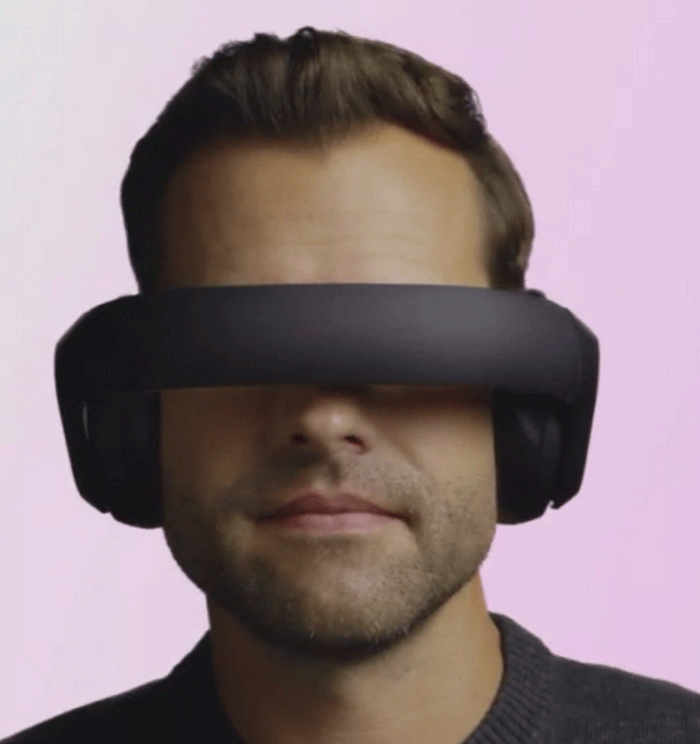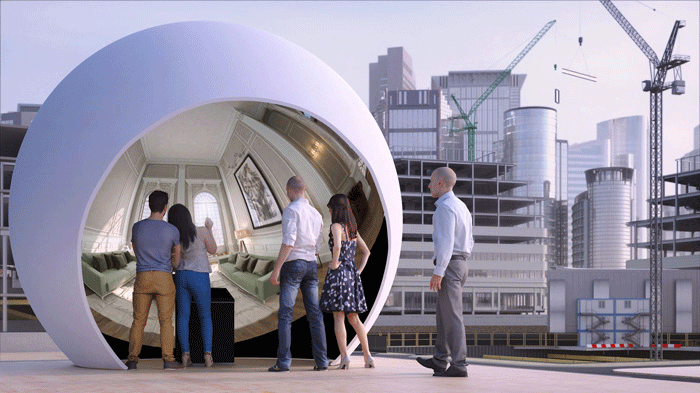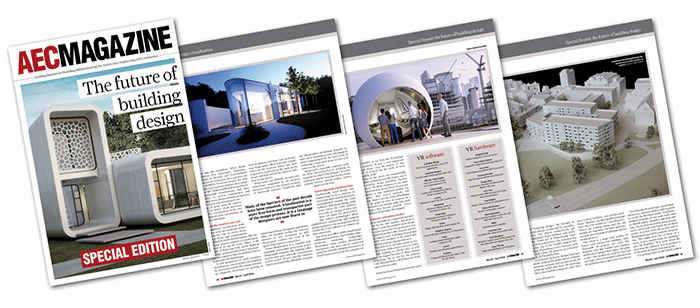Several hardware and software trends are converging to create incredible new design workflows. By Randall S. Newton
Virtual Reality (VR) has been a “next big thing” for 30 years. The idea of using an immersive, 360-degree computergenerated visual experience has become a science fiction trope and a constant source of speculation in the computer graphics industry.
For AEC specifically, the idea of having a three-dimensional view of the building model from the inside is very appealing. What has been lacking for such immersive viewing is the development of a comprehensive hardware and software stack. By “stack” we mean such elements as file formats, conversion tools, other software framework elements, along with the equipment required to bring a VR system to reality. Much of the stack is coming to AEC thanks to recent developments in the consumer market; the rest is being built by vendors and end users working together.
The change from hype to happening comes from huge investment in the consumer market for VR. Some of the largest names in software and hardware are investing millions in making virtual reality a household phenomenon. Microsoft, Google, Facebook, Sony, Samsung, HTC, and a pack of smaller but important players are all bringing virtual reality products to market — or have done so already. A $500 Oculus Rift headset might be an expensive toy for the home, but if architects or builders can use one to deliver stunning views of architectural models, it is cheap.
Head-mounted displays (HMD) are the final step in delivering 3D content as a virtual reality experience. Behind the viewer, other technologies had to mature or adapt to make the AEC Virtual Reality stack come together.

It starts with data
Virtual reality is a graphics technology; so are CAD and BIM design tools. But you can not simply hand off your BIM model to a virtual reality head-mounted display with the click of a button. “Live Design” was the title of a launch demonstration November 2015 at Autodesk University.
A Revit architectural model of a San Francisco penthouse apartment was exported to 3ds Max, a popular tool for creating visualisations from architectural data. Next the data was sent to Stingray, a new real-time 3D games engine Autodesk recently acquired. (Stingray technology is being added to Autodesk’s visualisation products: 3ds Max, Maya, Maya LT).
Once inside the Stingray environment, the Revit data can be displayed as an interactive model, the way one interacts with a game. But because the viewing device is a 3D head mounted display with 360 degrees of viewing available, the result is an immersive experience.
Using an HTC Vive headset and a wand (like a mouse for immersive environments), viewers could walk through rooms, open windows, strip back walls to look at construction details, or reveal measurements hidden in the model.
Revit to 3ds Max to Stingray to Vive is one possible virtual reality stack, but many others are emerging.
One company already using VR in AEC is Rewind, a creative agency and digital production studio that has engaged with AEC clients for years. Rewind has decided to double-down on virtual reality, aligning their creative team with work in this new medium.
A recent project for Savills, a UK-based global real estate services firm, demonstrates both the wow factor and the bitsand- bobs approach required to create a VR demonstration.
Savills wanted to create a virtual reality tour of a £16 million mansion in the English countryside. The team, led by Rewind managing director and creative lead Solomon Rogers, used a LiDAR 3D scanner to create dense 3D point cloud models of the exterior and interior. The house was also captured using video and still photos; the combination of the three technologies delivered both realism and “a feeling of space and scale that an effective property tour needs to provide”, says Mr Rogers.
LiDAR 3D point cloud data comes as a series of scans, which have to be knit together to make a single model. Rewind used Sequoia from Thinkbox Software, a new purpose-build tool for meshing and processing that has been in development for three years, with AEC as a primary target market. Once the 3D data had been converted into a coherent model, Rewind moved it to Autodesk 3ds Max where the scan data was converted into a visualisation- ready model.
“Sequoia was great for initial workflow,” notes Mr Rogers. “Then we did more clean-up in Max. Laborious but worth it.” From viz prep in 3ds Max the model was then imported into Unity, a leading commercial game engine. Real-time shading information was added to the model in Unity, then exported into two versions, one designed for VR presentation, another for the flat screen. Oculus Rift was the headset of choice for this demonstration. The final “product” was showcased at the “Masterpiece” real estate exhibition in London, and is now on display at Savills’ headquarters.

The AEC/VR tipping point
“We are at the tipping point between novelty and necessity,” says Mr Rogers. What today is “experimental and hand built” will soon be accessible to every AEC firm. “VR helps people see designs as they’ve never seen them before. The use of stereoscopic and VR tech will be a real game-changer in design.”
Mr Rogers attended the Live Design was thrilled to see how the technology was received. “It was a very important launch demo,” says Mr Rogers. “It was proof of concept for the tools. It went incredibly well.”
When all the pieces are commercially available and integrated, Mr Rogers says it will redefine design workflow. “Instant access in VR allows humans to use sight and movement to access detail. No amount of photos or tiny cardboard models can compete.” New review methods will emerge. Rogers says the study of buildings from the point of view of someone in a wheelchair is one example of the new methodologies that become possible. “Game workflow is what makes this happen.”
Key players: emerging market
There is currently no commercial turnkey VR kit for the AEC market. Autodesk is working to make the products in its design suites interoperate for VR production, but independent products like Sequoia and the game engines (also including Unreal and Blender) will continue to be mixed-and-matched by cutting edge practitioners.
What follows is our bullet-point assessment of some of the players who are either already working on VR for AEC or will have an impact because of their existing technology. We do not list the primary CAD/BIM products; all of them are working on virtual reality.
VR software
Autodesk ReCap
Process 3D point clouds for use in VR applications.
Autodesk Stingray
3D game engine being repurposed for AEC.
Blender Game
Engine Open source game engine, can be repurposed for VR.
Chaos Group
Leading AEC visualization software vendor, working on VR.
IrisVR
Software to convert 3D AEC models to VR.
Matterport
Hardware/software combo for converting 3D data to VR.
PocketCake
Mobile game developer working on VR apps including AEC.
Soluis
Studio with experience in developing VR.
Thinkbox Sequoia
Convert 3D point clouds for use in VR projects.
Unity
Leading commercial 3D game engine suitable for VR.
Unreal
Popular game 3D game engine Horizon.
Worldviz
Custom development and studio work for AEC firms
VR hardware
Avegant Glyph
Stylish, designed as “personal theatre”.
Daqri
Smart Helmet Designed for augmented reality more than VR.
Eon iCube
CAVE system, but will cost kill VR in a cave?
Facebook Oculus
Does the headset with the most buzz win?
Google Glass
Scorned and ridiculed, it is still in the lab. Obvious AEC uses.
HTC Vive
Critics love this HDR but Sony and Oculus have more mindshare
Leap Motion
Project Orion Controls VR with hand waves Microsoft Hololens The first “holographic computer’
Microsoft Kinect
Kinect introduced millions to 3D tech; will find niche uses in VR
MYO
Armband motion controller.
Samsung Gear
On sale for $99, means there will be users.
Sony Morpheus
Headed to market as part of PlayStation VR, may make sideways entrance into AEC.
Zeiss VR One
Optics specialist invests in VR headset
This article is part of an AEC Magazine Special Report into the Future of Building Design, which takes a holistic view of the technologies and processes, which are set to change and enhance the AEC industry in the coming years — from concept design all the way to construction.
Click to read the other articles that make up the report.
1) Introduction New technologies are empowering architectural firms to improve quality, capabilities and process.
2) Conceptual design There are a whole host of digital tools for early stage design experimentation.
3) Rapid site design The rapid capture of site topology is being aided by new technologies.
4) Benefits of 3D design Evolution, not revolution when making the move to 3D CAD.
5) Moving to model-based design How to get from 2D to 3D, how to roll out training and how to overcome common issues encountered along the way.
6) Design viz Advanced new rendering technologies are opening the door to design realism in architectural workflow.
7) Design, analysis and optimisation Once you have a 3D CAD model, optimse your design for daylighting, energy performance and much more.
8) Collaboration and model checking How to share models with clients, contractors and construction firms and test the quality of your model.
9) Workstations What to look out for when choosing a workstation for 3D CAD.
10) Virtual Reality New technologies are now available to support powerful new design workflows.
11) 3D printing Architects are 3D printing architectural models with impressive results.
12) Fabrication As building time gets compressed what will revolutionise fabrication and construction time?

If you enjoyed this article, subscribe to AEC Magazine for FREE






